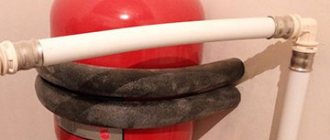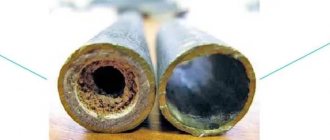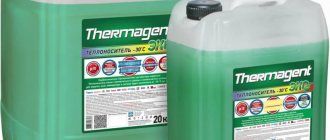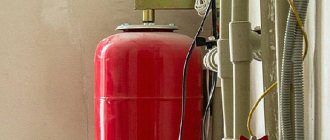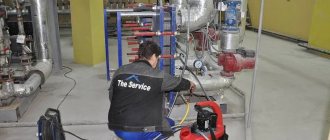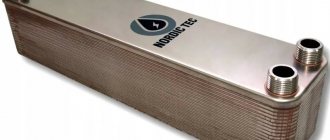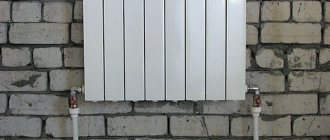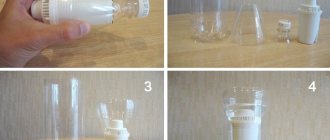When faced with repair work, going on a long trip or becoming a victim of an emergency, many people wonder whether it is necessary to drain the water from the heating system? In most cases, the answer is positive, although there are also situations where it is possible to fix a problem or make repairs with radiators filled with liquid.
Although the draining procedure is not particularly complicated, following the operating rules is an important nuance. If you violate the procedure, you can flood the floors in your own home with water. And if the drainage is carried out in a multi-story building, then neighbors may also suffer from incorrect actions.
Why do you have to add water to the system?
For the boiler to work correctly, it is necessary to maintain the recommended pressure in the system. Obviously, for this to happen, a constant volume of coolant must circulate in the water heating system. And it can change during operation even in a perfectly designed and assembled structure. Loss of coolant occurs when:
- The air is bleed through the Mayevsky valve located on the radiator. As you know, you have to open the air vent and wait until a trickle of water comes out of it.
- In automatic mode, excess pressure is released through a safety valve due to a change in the operating mode of the system. In this case, the coolant escapes into the atmosphere in a gaseous state.
- The filters are cleaned from mechanical contaminants.
- There are significant or microscopic leaks, for example through dismountable connections.
- In systems with natural circulation, water evaporates through an open expansion tank.
Video description
Video on how to install the make-up valve:
- If replenishment is carried out through the return, then the boiler must be turned off. Otherwise, cold coolant entering a heated heat exchanger can lead to thermal deformation of the latter. This is especially true for cast iron models.
- Automatic make-up for a floor-standing boiler with a cast-iron heat exchanger is best done through a direct manifold.
- If possible, it is better to make replenishment through a hydraulic arrow so that the cold coolant quickly mixes with the hot one and eliminates thermal shock for the heat exchanger.
- On condensing-type boilers, it is advisable to install the make-up in the return line - to increase the efficiency of the system.
- If there is indirect heating in the boiler system used for hot water supply to the house, it is allowed to supply heated water from it for replenishment through the return line.
Reference! Modern boiler models from official manufacturers are equipped with technical documentation, which includes important technical information. This is, first of all, a diagram of the correct piping indicating the location of the recharge unit.
How recharge works
The main task of the make-up unit is to add the missing coolant to the heating system until the operating pressure returns to normal. In most cases, heating make-up is connected to a cold water supply, but the system can also be powered from a storage tank. There are two ways to replenish the coolant volume.
- Manual mode. It is usually used in small systems. The user himself periodically monitors the pressure using the pressure gauge and, when necessary, opens the appropriate taps. Water flows by gravity, or a make-up pump is used for heating. In the simplest gravity installations, water is collected until it comes out of an overflow pipe welded to the expansion tank.
- Automatic recharge of the heating system. If the pressure in the system drops below the set value, the heating system feed valve (or electric valve/valve) is activated, which opens the flow hole. If necessary, voltage is applied in parallel to the sediment, and water will begin to forcefully enter the system. When the pressure readings return to normal, the valve will close and the pumping equipment will turn off. Sometimes the power supply is part of the heat generator. The advantage of using automation is that there is no need to engage in control; everything happens without the participation of the homeowner. The disadvantage is the fact that another element appears in the circuit that needs power supply.
Note that this unit is used not only for adding water during operation. Through it the following is carried out:
- initial filling of coolant into the system;
- complete discharge of water (for example, for repairs);
- water preparation (coarse filtration, softening);
- flushing the system;
- crimping.
Video description
Video example of arranging automatic recharge of a heating system:
Another common problem is increased water hardness. It is formed by insoluble salts, which, when heated in the system, can form deposits in the form of scale and clog the coolant flow. To eliminate such consequences, the following methods are used:
- Chemical softening with reagents. Salts settle at the bottom of containers or settle in filters.
- Installations with ion exchange resins.
- Softener filters installed on household dishwashers and washing appliances.
- Reverse osmosis type filtration.
Note! If the water hardness is not very high or medium, then the functionality of a closed heating system that operates without leaks will not be particularly affected. Insoluble salts will quickly be deposited in a thin layer on pipes and heat exchangers, but will not affect the efficiency of the system as a whole. Another thing is flow plate heat exchangers. Due to the large volume of water passing through them, deposits will only grow over time and eventually simply clog the entire lumen.
Make-up device for heating system
Actuating mechanism
If replenishment is carried out mechanically, then all manipulations are carried out using one valve. Automatic units use various types of remotely controlled valves. But in most cases, a pressure reducing valve for automatically recharging the heating system is used. Typically this is a combination device that includes a shut-off valve, a check valve and a pressure reducer. It can be mechanical or have electrical contacts to control the pump.
The device is adjusted to the required operating pressure range. When the lower coolant pressure threshold is reached (say, 5 or 10 percent), the membrane releases a spring, which moves the working rod with a cone that closes the flow hole of the valve. After pumping the system to the required pressure level, the membrane compresses the spring and closes the flow with a rod.
The valve response pressure is adjusted using a screw located on top of the device. Once installed in the desired position, it is secured with a lock nut. To visually monitor the pressure during adjustment, the valve is equipped with a pressure gauge.
Check valve
Under no circumstances should hot water from the heating system enter cold water supply pipes. Firstly, it can lead to the development of bacteria in drinking water. Secondly, waste coolant can be quite harmful to humans, since corrosion products accumulate in it. Thirdly, this way we lose coolant, which again negatively affects the operation of the heating installation. Reverse movement of the coolant can occur during replenishment if the pressure in the supply line is insufficient (in the water supply it is lower than in the heating system), or during operation if the shut-off valve “does not hold.”
The check valve is always installed at the rear of the actuator and is often built into the pressure reducing valve body. Recently, the make-up unit is also equipped with a check valve at the front or a so-called “flow breaker” is used.
Pump and accumulator
The main task of the pump is to increase the pressure in the supply pipeline, for example, when the pressure in the cold water supply pipes is lower than in the heating system. Therefore, it will not be possible to add water to the heating either manually or automatically. And if the check valve is absent or malfunctioning, there will also be an additional loss of coolant.
Important! For private homes, vertical submersible heating pumps can be used, which take water from wells.
A storage tank connected to the make-up unit allows you to always have a supply of water with which you can replenish the system, regardless of the pressure level in the drinking pipeline. To manually replenish the coolant in gravity circuits, a container is used that is located above the expansion tank, that is, somewhere in the attic. Automatic recharge systems often use a hydraulic accumulator with a membrane, which is always under pressure.
Filter elements
Impurities found in water can negatively affect the operation of heating and even damage heating appliances and devices. It is best to filter and prepare water immediately at the “inlet”. For mechanical cleaning of the coolant, mesh filters are used, which are mounted upstream of the pressure reducing valve. Sometimes mud collectors are an integral part of the actuator. To soften water (mainly to combat calcium salts), filters are used that bind and precipitate “unnecessary” substances using chemical reagents.
Manual recharge scheme
The easiest way to replenish the heating circuit with water is to refill it manually. In order to fulfill it, it is necessary to stretch a pipeline from the city water supply and connect it to the return line of the heating network. A shut-off valve and a water purification filter are installed in this area.
The scheme functions perfectly in simple heat supply systems for one-story small-area households. The line is connected to the return line before the circulation electric pump, since this section has the lowest pressure and temperature of the network water.
For open heating networks, the make-up system organizes the supply of water not to the return, but directly to the expansion tank. To do this, you do not need to go into the attic to check the recharge level. According to the diagram, the expansion tank is connected with 3 independent terminals: make-up, supply and return pipelines.
The level in the tank is controlled by opening the valve on the control pipe directed to the sewer. When water flows after opening the valve, this means that the system is full; if not, the make-up valve opens, which is kept open until there is overflow from the control pipe.
About connecting the make-up
The ideal place to create a recharge unit is an area with minimal pressure, preferably at the lowest point. Make-up is done on the return line, however, so that too cold water does not enter the heat generator (this is not very good for the heat exchanger of a working boiler), the pressure reducing valve is somewhat removed from the boiler or even placed on the DHW pipe if the heating device is double-circuit. In order to be able to service/repair the automatic make-up unit and not turn off the heating during this time, it is connected using a bypass and shut-off valves.
Describe your question in as much detail as possible and our expert will answer it
The make-up tank in the photo has a ball installed at the top.... maybe there is a pipe below in the tank itself? And why such tanks, if there are balls right below.
Is it necessary to turn off the boiler when recharging a closed heating system?
Before the start of the heating season, it is necessary to carry out comprehensive maintenance of the heating circuit. Such measures include flushing the system and checking the functionality of the equipment. After this, you need to fill the closed heating system and bleed all the air. There are several ways to fill a contour. It is very important to monitor the pressure level while performing work. The optimal operating pressure values are indicated in the passport of each circuit element.
Advantages
A closed system has the following positive characteristics:
- safe pressure;
- contact with the environment is limited, which prevents the entry of air that could disrupt operation;
- use of specialized tanks for pressure safety;
- dividing the tank into two chambers: one of them is a gas storage (mainly nitrogen), and the second is a water chamber;
- safe work process;
- a specialized valve in the tank maintains a safe pressure level.
In practice, a closed structure rarely fails, which is why it is popular.
Selection of coolant
If you fill the circuit with low-quality coolant, the equipment will not last as long as it could. Therefore, before filling the heating system in a private home, you need to select a coolant suitable for your situation. There are only two options - water or non-freezing liquid. In a house where you live constantly, it is better to give preference to water, since there are fewer problems with it, especially if it is distilled. Such water contains almost no impurities of salts and metals, which negatively affect all elements of the heating circuit.
Non-freezing liquid thickens at sub-zero temperatures. It is used when the heating works from time to time. The characteristics of non-freezing liquid impose some restrictions:
- high degree of fluidity - leakage may appear where water would not leak;
- Do not overheat - when heated to 95 degrees, it decomposes into acid and other elements;
- if the liquid has thickened, then heating should be gradual;
- Anti-freeze has a resource (depending on the manufacturer, on average 2 seasons).
Polymer thermal insulation Penoplex has one of the lowest thermal conductivity coefficients.
If you insulate a timber house with Penoplex, the wood will not breathe and will rot very quickly.
Antifreeze cannot be used if you have a double-circuit boiler installed. Liquid can seep through protective gaskets, so it happens that colored water flows from a hot water tap. In any case, only non-toxic antifreeze based on propylene glycol should be poured into the system. After all, there is also antifreeze based on ethylene glycol - this is car antifreeze. Some people also pour it into the heating system, but we do not recommend doing this.
Coolant replacement reasons and frequency
Replacing water in a closed and open heating circuit is carried out:
During the first heating start.
After installation, the system is filled and started
After seasonal drainage.
When starting after repair work.
Regular topping up of liquid is required during operation if it has not been drained after the heating season.
Why drain your home system?
A question for which there is no clear answer is whether it is necessary to drain the circuit annually after the end of the heating season? The decision depends on the type, age and material of manufacture of the main elements - pipes and radiators, as well as on the total volume of liquid.
Each type has its own frequency of media replacement
Most often, systems with old cast iron radiators are drained for the summer. The reason is the appearance of a leak after the boilers are turned off. The old cast iron ribs are connected to each other by threaded connections with old gaskets. When there is hot water inside the batteries, the seals expand, providing a stable seal at the seams.
After the water cools, the material from which the gaskets are made naturally contracts and begins to flow at the junction of the ribs. But prolonged idle time of old radiators without water is fraught with accelerated corrosion; the rust inside the radiator and old pipes crumbles in a dry environment, and can damage the entire riser.
In closed new circuits, filling the heating system is not a costly process. But it is not recommended to completely drain the liquid every year - this is not necessary.
Frequency of replacing and topping up fluid in the heating system
How often do you need to change the fluid in your heating system? A few general rules:
In open-type circuits of private houses, it is enough to simply add water if the system is sealed, without subjecting the old communications to stress tests in the form of long dry periods. Replacement is necessary only in case of emergency repair or preventive sealing, after washing.
If a leak occurs, it is necessary to drain the water and carry out repairs.
Closed heating systems require preventive flushing and replacement of the coolant after several years.
The frequency of filling with new liquid depends on the characteristics of the water, the service life of the synthetic coolant, and the general condition of the system. If the extreme points are very airy, it is recommended to identify the cause - find the location of the leak and check the tightness of the heating network. Typically, water changes are carried out every few seasons.
How to fill a heating system through make-up
Filling a closed-type heating system through make-up is only possible if the circuit is connected to a water supply system. In autonomous systems, this is the best option, since it does not require the purchase of additional equipment.
It is advisable to install not a ball valve on the feed, but a valve that can be used to regulate the flow. Before filling the heating system with water, you need to empty it of old coolant. The water changes because it becomes too dirty. Then you need to open all the Mayevsky taps on the radiators and open the make-up.
As the radiators fill, liquid will begin to flow from the air vents at the ends. As soon as water appears, the tap is immediately turned off. You need to monitor the readings of the pressure gauge - a device that shows the pressure in the heating circuit.
In autonomous systems it should not be more than 2.5 atmospheres. This value is achieved when the temperature of the coolant increases, and when the water is cold, the pressure gauge should show no more than 1.5 atmospheres.
After filling the heating system with water, you need to turn on the boiler. When the coolant heats up, you need to bleed air from all batteries again. In hot water, air separation occurs more intensely than in cold water. It may be necessary to remove air pockets several times (the first 2-3 heating cycles of the coolant).
Finally, about the safe addition of coolant
When filling water or partial replenishment, follow our recommendations:
- Replenish the heated system slowly by opening the valve a quarter of the lever stroke. In this way, it will be possible to avoid the formation of air locks and protect the boiler heat exchanger from temperature shock.
- Refill from scratch with the heat generator not working and the circulation pump turned off.
- Check the pressure in the expansion tank and go through all the radiators, opening the Mayevsky valves to release air.
- If your boiler is equipped with modern electronics, be sure to study the instructions regarding make-up. Often it is necessary to activate a special service mode in the unit.
- Excess pressure is easily released through the nearest air vent.
The complex system make-up module can be connected to a hydraulic separator and a comb
Reference. Cast iron heat exchangers easily crack from sudden temperature changes, and steel fireboxes become covered from the inside with condensation. The latter mixes with soot and forms a dense coating.
Injecting antifreeze with a hand pump does not have any pitfalls. Pressure testing units are equipped with their own pressure gauge, which allows you to monitor the current pressure at the insertion point.
Filling closed heating with a pump
If the circuit is not connected to the water supply, the only option left to fill the heating system is a pressure test pump. This is a small rectangular metal reservoir into which liquid is collected. From the reservoir, the coolant is supplied to the pipes thanks to a pump-action hand pump on which a pressure gauge is installed.
Hand pump for pressure testing.
There is nothing complicated about how to fill a closed heating system. Work algorithm:
- connect the hose from the pump to the circuit;
- pour coolant into the pump reservoir;
- manually pump fluid into the system.
If there is no pipe for draining water from the circuit, then you can connect the pump hose to one of the ends of the battery. To do this, you need to unscrew the plug and put the adapter in its place. Before starting work, be sure to open all air vents so that air can leave the circuit.
There is no point in gluing roll insulation under the wallpaper. A thin layer of thermal insulation will not give the desired result.
When working with thermal insulation in sheets and rolls, you need to use an insulation dowel or nail to fix the material.
Watch the pressure gauge reading carefully. Using such a pump, pressure testing of the heating system is carried out. They can pump up pressure to 10 atmospheres (if you have enough strength). When filling the system, such pressure is not necessary, otherwise the boiler will break.
Filling heated floors
Warm floors have their own characteristics. They are not filled all at once, but one contour at a time. If you fill everything at once (and they have different lengths), then there will definitely be air in the long circuits, which is almost impossible to remove from there. Therefore, we proceed as follows.
The collector is completely assembled. All circuits are blocked on the return line except one. The pump is turned on, and through the supply, this circuit is filled with the heating system until clean coolant flows out of the drainage hole without a sign of air. After this happens, the circuit closes. All the others are filled in in the same way.
Here it is advisable to have another hose in order to direct it into a bucket of coolant to avoid its spillage.
After this, the drainage hole is closed, all circuits are opened and the operation of the heated floor is checked. It is important to pay attention to the fact that the radiator network system can be filled with coolant against its movement. You cannot do this with heated floors; you only need to fill it from the straight side, because otherwise the coolant will not move through the rotameters.
Filling the system through a double-circuit boiler
Now let's look at the simplest method, namely how to fill the heating system of a double-circuit boiler. These units do not require the installation of an additional unit for feeding the heating circuit, since it is included in the basic configuration.
The feed tap is located at the bottom.
Look into the bottom of the boiler. Near the cold water supply pipe from the water supply there should be a plastic handle for the make-up tap. In principle, the procedure is no different from refilling through a water pipe:
- open all air vents;
- open the feed tap and fill the system;
- As the circuit fills, close the air vents;
- we achieve pressure (specified in the boiler passport).
Types of coolants and requirements for them
In autonomous heating systems for a private home, the following types of liquid coolants are used:
- Water.
This is the most common type of coolant, which has the following advantages:
- Minimum price.
- Availability.
- Maximum heat capacity (ability to transfer heat).
- Low viscosity, which means the least load on the circulation pump.
- Low corrosiveness - only in the presence of dissolved oxygen.
- Ecological cleanliness.
- Small expansion coefficient - no more than 0.03%.
Water is the most common and accessible coolant for most heating systems Source eurosantehnik.ru
The disadvantages of using water as a coolant are manifested in corrosion activity on unprotected steel parts of the system, as well as high crystallization temperatures. Therefore, if the house is left in cold weather long enough to cool the premises to 00C, then the water will need to be drained. Otherwise, under the force of expansion, freezing water will rupture pipes, batteries and heat exchanger.
- Antifreeze.
It is an antifreeze for radiators of cars operated in cold weather. Recently, they have preferred to fill autonomous heating systems of only closed types - due to the high toxicity of the vapors, they are not used for open circuits. It is marked with numbers - 65, 40 or 30 - which means the freezing mark of the liquid at a temperature below zero.
It is characterized by the following number of features:
- Average market price.
- The heat capacity is average, but lower than that of water.
- High viscosity - which characterizes a high load on the pump.
- Almost complete absence of corrosive activity.
- Toxicity - due to the ethylene glycol included in the composition.
- The expansion coefficient is up to 0.05% - almost 2 times higher than that of water.
Antifreeze contains harmful ethylene glycol, so it can only be used in closed systems Source otoplenie-gid.ru
Unlike water, antifreeze does not cause corrosion, but this is not always a good thing. So, for example, if a heating circuit becomes depressurized, fluid will begin to leak, while water and other corrosive liquids will quickly “heal” the leakage points by forming rust.
- Propylene glycol.
Antifreeze liquids based on propylene glycol are produced on an industrial scale specifically for autonomous heating systems.
Main operational features:
- Low heat capacity. In its pure form, it is almost 2 times lower than that of water. However, when diluted with water, the indicator increases to an acceptable level.
- High viscosity, which creates additional load on pumping equipment.
- Expansion coefficient – no more than 0.05%.
- Harmlessness.
- Lack of corrosive activity due to additives.
Although propylene glycol is the most expensive on the list of antifreezes under consideration, its popularity is high due to its absolute harmlessness. In purified form, it is added to both cosmetics and confectionery products.
Propylene glycol is the best antifreeze option for the heating system of a private home Source santehexpress.ru
- Brine.
The product is a solution of simple salts - common table salt, calcium chloride and some others. It is used as a budget alternative - to fill the heating system in a private home instead of water. The higher the salt concentration, the lower the freezing point of brine.
Features of operation:
- The lowest cost is based on the price of the amount of salts used.
- Sufficient heat capacity - 2/3 of that for water.
- Minimum viscosity.
- Expansion coefficient – 0.03%.
- No toxicity.
The main disadvantages manifest themselves in the form of low fluid mobility with a high concentration of salts and high corrosion activity on the walls of the metal elements of the system.
Metal elements rust quite quickly when in contact with salts Source vyborradiatora.ru
See also: Catalog of companies that specialize in engineering systems (heating, water supply, sewerage and others) and related work
Selection requirements
The liquid poured into the heating system as a coolant must meet the following series of requirements:
- High specific heat capacity.
The parameter characterizes the amount of thermal energy that must be supplied to 1 kg of a substance to raise its temperature by 10C. For heating fluids, this figure should be as large as possible. Ordinary water has the highest indicator among other liquids poured into the circuit.
- Operating temperature range.
Each individual coolant has its own characteristic operating temperature spectrum. Violation of these conditions leads either to equipment damage or to irreversible loss of coolant properties.
For example, when water freezes, it expands and ruptures the pipes or radiators in which it is located. On the other hand, organic coolants, when heated above 1000C, decompose into individual components, forever losing their original characteristics.
Any industrially produced coolant has a strictly specified operating temperature range Source sdvor.com
- Corrosivity.
The chemical activity of the coolant can lead to rusting of the metal parts of the circuit. The problem can be solved with inhibitory additives. For this reason, many coolants include special additives.
However, the problem most often manifests itself when the coolant is in constant contact with oxygen, and is practically absent when dissolved gases are removed from it.
This is especially true for ordinary water - after it is saturated with air bubbles at the point of contact - the expansion tank - it more actively corrodes steel pipes, radiators and other elements. Therefore, only closed-type heating systems are allowed to be filled with any type of coolant. In addition, they are most often equipped with plastic pipes that are inert to corrosion.
- Viscosity.
The viscosity index determines the degree of internal friction, and, consequently, fluidity. This in turn affects the pumping speed. Therefore, the greater its value, the more energy will be required to move the coolant through the system.
The promotion of viscous coolant is facilitated by the installation of powerful circulation pumps Source zaggo.ru
Water has the standard of minimum viscosity. All other coolants used in autonomous heating circuits have a higher value, and therefore worse fluidity characteristics.
- Lubricity.
Modern heating systems include a number of equipment in which the coolant additionally acts as a lubricant. This is not only a circulation pump, but also make-up and emergency shutdown valves, a thermostat, protocol sensors, pressure sensors, etc. Therefore, it is also necessary to select the liquid based on its lubricity in accordance with the specific type of system.
- Safety for others.
The substance used as a coolant in domestic heating systems must be completely safe for others. It should not be used in a vapor state, as if it ruptures due to the high temperature, it can cause burns.
Also, antifreeze should not be toxic, as, for example, compositions with ethylene glycol have. Therefore, for a number of reasons, domestic heating systems are most often filled with water.
The design of the heating system of a private house does not exclude contact of the coolant with household members, so it should not include toxic components Source klimatlab.com
- Chemical activity.
The coolant components must not interact with the heating circuit components. For example, if the heating system of a double-circuit boiler with steel radiators is filled with ethylene glycol, then the internal zinc coating of the batteries will quickly become thinner.
Moreover, heating the coolant to standard 80-900C will lead to the loss of its basic properties - the fluidity will become higher than that of water. Over time, this will inevitably lead to leaks of various connections with seals based on rubber, paronite and other polymers.
Recommendation! In most cases, water is used to charge the heating circuit. However, if the use of antifreeze cannot be avoided, for example, when the house is periodically left for a long time without heating during cold periods, then the choice is recommended to be made in favor of products based on propylene glycol. At the same time, it is better to purchase products from well-known lines with technical documentation confirming the quality.
The use of antifreeze will help avoid freezing and rupture of pipes and radiators if the house is left without heating in cold weather Source santehplus72.ru
How to use a heating system with a gas boiler
To ensure high-quality operation of the heating system using a gas boiler, it is necessary to understand the principles of its operation and follow the rules for installing and operating the boiler.
The information below will help you do everything correctly, following the manufacturers' recommendations and rules for using such equipment. Starting the heating system
Installation and commissioning of the boiler must be carried out by specialists. This process consists of several stages: installation, filling the system and setting up its operation. How to fill a heating system with water:
- Before you start filling, you must open the automatic pump aerator;
- then the fill valve opens and remains open until the pressure gauge shows a system pressure of 1.5 bar. After this, the valve closes;
- then the air vent valves on the batteries are opened to release the accumulated air. In this case, the pressure in the system drops, and the filling valve is reopened, bringing the pressure in the system to 1.5 bar;
- If necessary, the operation is repeated until air in large quantities stops accumulating in the system.
You need to know that air enters the system with water in any case, this is normal. Small amounts of air are removed from the heating system using a deaerator installed on the pump. This leads to a gradual decrease in pressure. If during operation of the boiler the pressure gauge shows a pressure below 0.5 bar, you will need to add water to the system again.
How to add water to the heating system
If the water pressure has dropped to a critical level (0.5 bar or below), it must be increased by adding water. On boilers with an LCD screen, this situation can be indicated by a code that stands for “low pressure”. We carry out recharge observing the following rules:
- turn off the heating boiler and de-energize it by unplugging the plug from the socket;
- carefully inspect the entire heating system and the boiler itself to make sure that there are no coolant leaks (they can also cause a decrease in pressure);
- using the filling tap, we bring the pressure in the system to 1.5 bar in the same way as when initially filling with water;
- After closing the valve, the boiler can be turned on.
The make-up valve must be closed in any case. Otherwise, the pressure in the system may rise to critically high levels. Typically this value is 3 bars. In this case, the automation will work and excess water will be discharged using a safety valve.
How to drain water from a heating system
In some cases, for example, when leaks are detected or other situations requiring repairs, it is necessary to drain the coolant from the system. This is easy to do by following these instructions:
- be sure to turn off the boiler and remove the plug from the socket;
- open the valves on the radiator and boiler;
- open the drain tap. It is located at the lowest point of the heating system;
- drain the water until the pressure gauge reads zero.
In double-circuit boilers, it will also be necessary to drain the water from the hot water supply circuit. To do this, after the boiler is completely turned off, open the cold water supply valve and one of the hot taps to ensure complete drainage from the DHW system.
Signs of a critical coolant shortage
Not all owners of private houses monitor the technical condition of their water heating; it works - and that’s okay. When a hidden leak occurs, the system continues to function for some time until the amount of coolant drops to a critical level. This moment is monitored by the following criteria:
- In an open system, the expansion tank is first emptied, then the main riser rising from the boiler is filled with air. Result: cold batteries when the supply pipeline overheats; turning on the maximum speed of the circulation pump does not help.
- The lack of water during gravity distribution manifests itself in a similar way; in addition, the gurgling of water in the riser can be heard.
- On a gas heater (open circuit), frequent starts/turns of the burner are observed - clocking, the TT boiler overheats and boils.
- The lack of coolant in a closed (pressure) circuit is reflected on the pressure gauge - the pressure gradually decreases. Wall-mounted models of gas boilers automatically stop when they fall below a threshold of 0.8 Bar.
- Floor-standing, non-volatile units and solid fuel boilers continue to regularly heat the remaining water in a closed system until the volume vacated by the coolant is filled with air. The circulation will stop, overheating will occur, and the safety valve will operate.
Important clarification. When a TT boiler operating in an open gravity system boils, there will be no explosion, since the coolant communicates with the atmosphere. The water heated by the heater will evaporate, and then a fire will start in the boiler room. Although the described process takes a lot of time, such situations are far from uncommon.
We will not explain why the system needs to be recharged - this is an obvious measure to maintain the functionality of the heating. All that remains is to choose a method for replenishing the heating network.
How to drain water from pipes for the winter
With the advent of the first cold weather, many owners of private houses and summer cottages have a need to drain water from the pipes of their plumbing and heating systems. Many people think about how to drain water from pipes with their own hands, they think that it is very difficult, and the help of specialists is needed. In fact, you can do this on your own.
Adviсe
When preparing water pipes for conservation, it is worth remembering that all work must be carried out at an outside air temperature of at least 5 ⁰C.
In order to properly drain water from water pipes, their design must include the following details:
- A tee and a drain valve must be installed on the pipe valve supplying water from a well or well caisson.
- Water pipes must be made of low-density polyethylene or polypropylene. This will prevent them from being damaged during emergency defrosting.
- A water drain valve must be installed at the lowest point of the pipeline branch.
- If drain taps are not installed, a tee must be installed. A car compressor is connected to it. It is used to blow through pipes.
- If a water heater is connected, it is necessary to install a tee and a tap to drain the water. They must have a hose attachment to the check valve on the incoming water heating pipe. Also, a tee with a tap should be installed on the outlet pipe from the water heater to quickly supply air when draining the water.
Note! It is recommended to use classic ceramic faucets and taps with a rubber seal. They will not be damaged if residual water in the pipeline freezes.
Stages of draining water from a pipeline
To drain water from the heating system, you must perform the following steps:
- Turning off the heating boiler or closing the distribution valve on the pipe extending from the riser.
- Shutting off the valve that collects water into the heating system.
- A hose must be attached to the radiator system drain valve. Here you should correctly calculate its length. It must be sufficient to drain water into the street or into a sewer well.
- The drain valve on the heating radiator must be opened.
- On the heating system, it is necessary to open the valves with air valves. This will ensure a faster drainage rate.
- Leaks may occur during the draining procedure. To avoid unpleasant incidents, it is necessary to place a deep container in advance and place it under the junction of the tap and the drain hose.
- After completing the draining procedure, you must disconnect the hose and drain the remaining water into a container.
We drain water from the central and autonomous water supply
In modern summer cottages, many people install a pipeline system. The pipeline can be connected:
- to the central water supply,
- to an autonomous water supply system.
Conclusions and useful video on the topic
The video will clearly present the process of filling the heating circuit and setting the expansion tank:
Common to all coolants is gradualness when starting the system. The temperature must be increased slowly, step by step, not only because of the coolant, but also because of the additives, which also change their properties with temperature.
The process of filling systems with both water and antifreeze is similar, but the requirements for the quality of work and safety when filling with antifreeze are increasing. Antifreezes that have expired require disposable containers and removal for disposal.
If you have questions about the topic of the article or already have experience in filling heating systems with coolant, please share it with our readers. Leave your comments at the bottom of the article.
How to drain water from a heating system
When is it necessary to drain water from the heating system? Most often, the need for it arises when it is necessary to clean or replace a heating radiator, for example. If we are talking about a city apartment that is connected to a central heating system, then such an operation can be carried out independently on the internal section of the network. In the event that it is necessary to drain the heating system of a private house equipped with a boiler, it will have to be temporarily emptied.
The essence of the
The first step is to shut off the branch of the heating riser that goes to the apartment. It is enough just to close the distribution valve located here. For a private house with an autonomous heating system, this process is slightly different:
- firstly, you need to stop the supply of fuel or electrical energy;
- secondly, you should carefully read the user instructions for this case.
Only after this can the boiler be turned off. Then you should close the valve through which water is drawn into the system.
Only after this can the boiler be turned off. Then you should close the valve through which water is drawn into the system.
To speed up the process a little, you will need to know those places in the system where taps with air-type valves may be located. They all need to be opened. In this case, nothing will interfere with the flow of water to the hose.
During this operation, small leaks of water from the system onto the floor are possible. Therefore, at the very beginning, it is better to place a large bowl or basin under the place where the hose is connected to the tap (drain). As all the water leaves the system, it is necessary to disconnect the hose and drain the remaining water from it into a substitute container.
Only after completing all the described procedures can you move on to the main thing - to the work for which the water was drained from the heating system of a residential apartment or private housing construction.
If the owner of an apartment or house does not quite understand how to drain the water from the heating without harmful consequences, then it is better to contact a qualified contractor. For example, to a plumber from a company that services a specific home.
Boilers
Residential premises are heated by a boiler with one or two circuits. In the second case, the owners also provide themselves with hot water.
Many heating devices also have internal cavities where the coolant reaches a given temperature. And after draining the liquid from the unit, its interior becomes free of water, and convenient conditions are created for working with all components and contacts.
The nuances of emptying boilers in the house were reflected above. But there are some more subtleties:
How to drain water from a double-circuit gas boiler correctly? This means emptying the heat exchanger. To do this, turn off the boiler and open the hot water tap until it cools down. After this, the flow of cold water is blocked. If necessary, all its contents are removed from the heat exchanger. Then the hot water supply fitting is unscrewed.
How to drain water from a modern wall-mounted gas boiler? Such devices have a drain fitting and an air vent. These elements work automatically. And to free such a boiler from liquid, simply open the drain valve after the preparatory stages.
How to drain water from heating systems?
Home Article How to drain water from heating systems?
©advertising
Quite often this need arises when there is a need to clean or replace a heating radiator. For city apartments that are connected to a central heating system, this operation can be performed independently on the internal section of the heating network. If, however, there is a need to drain water from the entire system responsible for heating in houses in which a fuel boiler is installed, you will need to temporarily empty it of its contents.
Technology for draining water from the heating system
To begin with, the branches of the heating system riser going into the apartment are shut off. To do this, you just need to close the distribution valve located here. In private houses where an autonomous heating system is used, this process is slightly different. First, the supply of fuel or electricity to the heating boiler is stopped. Then you need to carefully study the user instructions, which describe this case in detail.
Only after this can the boiler be turned off. Next, the valve through which water is drawn into the system is closed.
To speed up this process, it is necessary to know those places in the heating system where the taps and air valves are installed. They all must be open so that there is no interference with the flow of water to the hose.
When carrying out this procedure, small local leaks of water onto the floor may occur in the system. That is why, before you start draining the water, you need to place a sufficiently deep container under the place where the hose and drain valve are connected. As water leaves the heating system, the hose is disconnected and the remaining water is drained from it into a previously placed container.
Only after completing all the described procedures can you begin the most important work, for which the water would be drained from the heating system of a house or apartment.
If the owner of a residential apartment or building does not quite know how to drain water from the heating system without negative consequences, then it is best to seek help from qualified performers in the form of a plumber from the company responsible for servicing a particular home.
Now the only water left in the water heater is to drain it too:
2. During installation, we always install a drain tap (6) and a safety valve (5). If the drain valve (6) does not have a flexible connection (optional), install it. With a flexible hose, it is more convenient to drain water into a container located on the floor. The volume of water drained is equal to the volume of your water heater!
3. Wait until the water is completely drained from the water heater drain tap. Now some water remains in the safety valve (5). To drain water from the valve, turn the lever on the valve up. Note: On some valve models, the tab is held in place by a small screw. The screw must be unscrewed, the water drained and put back in place.
Best answers
Konstantin Sukhorukov:
Only the heating engineer did not say what would happen to the boiler heat exchanger from the effects of antifreeze. If you want to use anti-freeze, then use liquids based on propylene glycol. And you can pump it without using a water pump, using a regular car pump and a lockable container with two fittings.
Larisa:
pump and hose
Alexander Bakushev:
open the emergency light and fill it until it runs out!
Andrey:
Pump a small container in the usual way and into it a cheap submersible pump, through a hose to the make-up tap, control the pressure using a standard pressure gauge, bleed air, pump and pump. Pre-pressurize the system with network water, check its operation under temperature changes. Evaporation of antifreeze and antifreeze inside a living space is goodbye to health and vision. for these reasons, fill it with an aqueous solution of drinking alcohol (vodka). Moreover, if the system is new and its volume is not very large, get a supply of the strategic product.
Bely Oleg:
Make two fittings in the canister, pour in anti-freeze, one hose goes to the boiler, and pump air into the other with a compressor from the refrigerator. The compressor from the refrigerator presses up to 8 bar - this is definitely enough for you. Productivity is just low. But they cannot pump any electrically conductive liquids - the windings there are not protected in any way...
Denisochka:
Where did the need for glycol coolant come from? When using it, heat transfer is reduced and boiler maintenance becomes more difficult, especially if the boiler is double-circuit with one heat exchanger. For almost any heating system, the best coolant is water.


